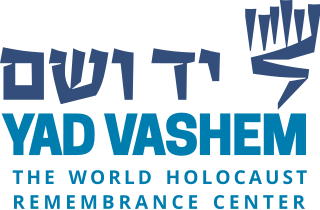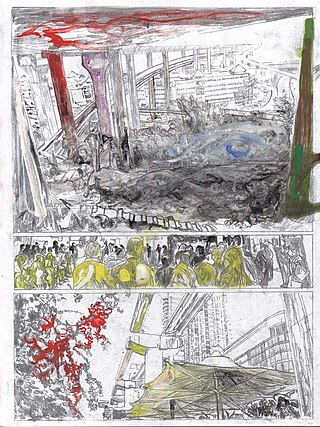
Yad Vashem is Israel's official memorial to the victims of the Holocaust. It is dedicated to preserving the memory of the Jews who were murdered; echoing the stories of the survivors; honoring Jews who fought against their Nazi oppressors and gentiles who selflessly aided Jews in need; and researching the phenomenon of the Holocaust in particular and genocide in general, with the aim of avoiding such events in the future. Yad Vashem's vision, as stated on its website, is: "To lead the documentation, research, education and commemoration of the Holocaust, and to convey the chronicles of this singular Jewish and human event to every person in Israel, to the Jewish people, and to every significant and relevant audience worldwide."

Daniel Libeskind is a Polish-American architect, artist, professor and set designer. Libeskind founded Studio Daniel Libeskind in 1989 with his wife, Nina, and is its principal design architect.

Jonas Mekas was a Lithuanian-American filmmaker, poet, and artist who has been called "the godfather of American avant-garde cinema". Mekas' work has been exhibited in museums and at festivals worldwide.

The Jewish Museum Berlin was opened in 2001 and is the largest Jewish museum in Europe. On 3,500 square metres of floor space, the museum presents the history of Jews in Germany from the Middle Ages to the present day, with new focuses and new scenography. It consists of three buildings, two of which are new additions specifically built for the museum by architect Daniel Libeskind. German-Jewish history is documented in the collections, the library and the archive, and is reflected in the museum's program of events.

The Memorial to the Murdered Jews of Europe, also known as the Holocaust Memorial, is a memorial in Berlin to the Jewish victims of the Holocaust, designed by architect Peter Eisenman and Buro Happold. It consists of a 19,000-square-metre (200,000 sq ft) site covered with 2,711 concrete slabs or "stelae", arranged in a grid pattern on a sloping field. The original plan was to place nearly 4,000 slabs, but after the recalculation, the number of slabs that could legally fit into the designated areas was 2,711. The stelae are 2.38 m long, 0.95 m wide and vary in height from 0.2 to 4.7 metres. They are organized in rows, 54 of them going north–south, and 87 heading east–west at right angles but set slightly askew. An attached underground "Place of Information" holds the names of approximately 3 million Jewish Holocaust victims, obtained from the Israeli museum Yad Vashem.

Arthur Szyk ; June 3, 1894 – September 13, 1951) was a Polish-born Jewish artist who worked primarily as a book illustrator and political artist throughout his career. Arthur Szyk was born into a prosperous middle-class Jewish family in Łódź, in the part of Poland which was under Russian rule in the 19th century. An acculturated Polish Jew, Szyk always proudly regarded himself both as a Pole and a Jew. From 1921, he lived and created his works mainly in France and Poland, and in 1937 he moved to the United Kingdom. In 1940, he settled permanently in the United States, where he was granted American citizenship in 1948.

Nazi plunder was the stealing of art and other items which occurred as a result of the organized looting of European countries during the time of the Nazi Party in Germany.

Mark Podwal is an artist, author, filmmaker and physician. He may have been best known initially for his drawings on The New York Times Op-Ed page. In addition, he is the author and illustrator of numerous books. Most of these works — Podwal's own as well as those he has illustrated for others— typically focus on Jewish legend, history and tradition. His art is represented in the collections of the Metropolitan Museum of Art, the Victoria and Albert Museum, the Israel Museum, the National Gallery of Prague, the Jewish Museums in Berlin, Vienna, Stockholm, Prague, New York, among many other venues.

The Holocaust had a deep effect on society both in Europe and the rest of the world, and today its consequences are still being felt, both by children and adults whose ancestors were victims of this genocide.

The Nazi book burnings were a campaign conducted by the German Student Union to ceremonially burn books in Nazi Germany and Austria in the 1930s. The books targeted for burning were those viewed as being subversive or as representing ideologies opposed to Nazism. These included books written by Jewish, half-Jewish, communist, socialist, anarchist, liberal, pacifist, and sexologist authors among others. The initial books burned were those of Karl Marx and Karl Kautsky, but came to include very many authors, including Albert Einstein, Helen Keller, writers in French and English, and effectively any book incompatible with Nazi ideology. In a campaign of cultural genocide, books were also burned en masse by the Nazis in occupied territories, such as in Poland.

The Musée d'Art et d'Histoire du Judaïsme or mahJ is the largest French museum of Jewish art and history. It is located in the Hôtel de Saint-Aignan in the Marais district in Paris.
Holocaust memorial landscapes in Germany encompass a large group of commemorative works dealing with the outdoor built environment. Most often these memorials attempt to keep the memory of Holocaust victims alive through dissemination of this memory to the public.

The KW Institute for Contemporary Art is a contemporary art institution located in Auguststraße 69 in Berlin-Mitte, Germany. Klaus Biesenbach was the founding director of KW; the current director is Krist Gruijthuijsen.
Holocaust studies, or sometimes Holocaust research, is a scholarly discipline that encompasses the historical research and study of the Holocaust. Institutions dedicated to Holocaust research investigate the multidisciplinary and interdisciplinary aspects of Holocaust methodology, demography, sociology, and psychology. It also covers the study of Nazi Germany, World War II, Jewish history, religion, Christian-Jewish relations, Holocaust theology, ethics, social responsibility, and genocide on a global scale. Exploring trauma, memories, and testimonies of the experiences of Holocaust survivors, human rights, international relations, Jewish life, Judaism, and Jewish identity in the post-Holocaust world are also covered in this type of research.
Pinhas Golan was an Israeli artist and sculptor. Golan was a Holocaust survivor and his work focused on the subject.
František Reichentál, also known as Frank/Ferenc, Reichenthal/Reichen-tal, was a Jewish Eastern European modern artist. He is known for paintings depicting his experiences of childhood poverty, captivity as a prisoner of war in Russia, escape from the Nazis, and finally fleeing from the Communists to start over in the United States.

The Leo Baeck Institute New York (LBI) is a research institute in New York City dedicated to the study of German-Jewish history and culture, founded in 1955. It is one of three independent research centers founded by a group of German-speaking Jewish émigrés at a conference in Jerusalem in 1955. The other Leo Baeck institutes are Leo Baeck Institute Jerusalem and Leo Baeck Institute London, and the activities of all three are coordinated by the board of directors of the Leo Baeck Institute. It is also a founding partner of the Center for Jewish History, and maintains a research library and archive in New York City that contains a significant collection of source material relating to the history of German-speaking Jewry, from its origins to the Holocaust, and continuing to the present day. The Leo Baeck Medal has been awarded by the institute since 1978 to those who have helped preserve the spirit of German-speaking Jewry in culture, academia, politics, and philanthropy.

Shimon Attie is an American visual artist. He was awarded a Guggenheim Fellowship in 2008, The Rome Prize in 2001 and a Visual Artist Fellowship from Harvard University's Radcliffe Institute for Advance Study in 2007. His work spans a variety of media, including photography, site-specific installation, multiple channel immersive video installation, performance, and new media. Much of Attie's practice explores how a wide range of contemporary media may be used to re-imagine new relationships between space, time, place, and identity. Much of Attie's works in the 90s dealt with the history of World War II. He first garnered significant international attention by slide projecting images of past Jewish life onto contemporary locations in Berlin. More recent projects have involved using a range of media to engage local communities to find new ways of representing their history, memory and potential futures. Attie's artworks and interventions are site-specific and immersive in nature, and tend to engage subject matter that is both social, political and psychological. In 2013, five monographs have been published on Attie's work, which has also been the subject of a number of films aired on PBS, BBC, and ARD. Since receiving his MFA in 1991, Attie has realized approximately 25 major projects in ten countries around the world. Most recently, in 2013-14, Shimon Attie was awarded the Lee Krasner Lifetime Achievement Award in Art.

Stefan Ettlinger is a German painter and draughtsman. He studied at the Kunstakademie Düsseldorf at Alfonso Hüppi as a master student. He lives and works in Düsseldorf.

Anna Walinska was an American painter. She is known for her colorful works of the Modernist period, collages done with handmade Burmese Shan paper, and a large body of works in various media on the theme of the Holocaust. Works by Walinska are included in numerous public collections, most notably the National Portrait Gallery, the National Museum of Women in the Arts, the Smithsonian American Art Museum, the United States Holocaust Memorial Museum, the Rose Art Museum at Brandeis University, the Denver Art Museum, The Jewish Museum in New York, the Herbert F. Johnson Museum of Art at Cornell, the Zimmerli Art Museum at Rutgers University, the Judah L. Magnes Museum in Berkeley, and Yad Vashem. Walinska's scrapbooks of the Guild Art Gallery, along with sketchbooks and journals on world travel are included in the Archives of American Art at the Smithsonian Institution.















